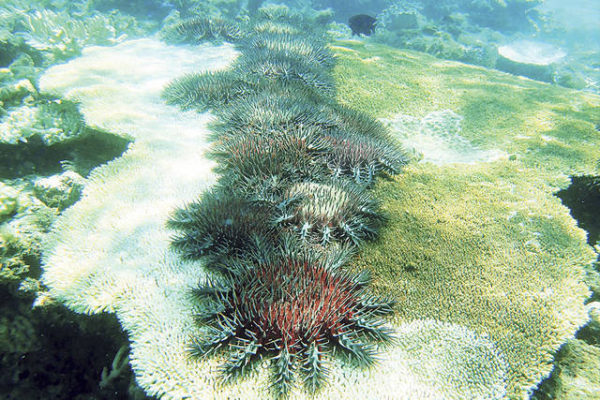Published in the Ocean Watch column, Honolulu Star-Advertiser © Susan Scott
October 26, 2018
Due to light winds and clear skies, Craig and I got lucky on our visit to Australia. Only three days after arriving we were able to motor-sail our 37-foot boat, Honu, directly to the outer reefs off Townsville.
Being anchored out there without a speck of land in sight kept us on high alert. Before we went to bed, we stowed gear below decks and brought aboard the dinghy’s outboard motor in preparation for a quick getaway. Any increase in wind strength, wave height or the appearance of thunderstorms would have had us rushing back to the safe harbors of inshore islands.
 These Crown-of-Thorns starfish eat their way across plate coral,
These Crown-of-Thorns starfish eat their way across plate coral,
leaving behind the dead corals’ white, cuplike skeletons.
©2018 Susan Scott
But whatever anxiety we suffered by anchoring our boat in places that felt like the middle of nowhere was well worth it. We saw with our own eyes what we read about the Great Barrier Reef.
We didn’t even have to get in the water to enjoy great beauty. At low tide when the clear water was only a few feet above the tops of the reefs, the purple, yellow and pink corals displayed their colors. Between them, over bright white sand, shimmered every shade of blue from navy to turquoise.
And then we got in the dinghy. Because of tidal currents between the reefs, we motored up-current to a coral patch, donned our snorkeling gear and jumped in, towing our 10-foot rubber dinghy with us. That way, we never had to worry about swimming against a current back to Honu.
We are both scuba divers, but no need there. The corals and their fish and invertebrate neighbors were just feet below our faces. To see the big guys, we swam to the reefs’ edges and looked down. We weren’t in the water five minutes when we saw our first shark, a 6- to 8-foot-long, rather bulky one, a species neither of us recognized. It passed us right by. As did a white-tipped reef shark later.
Not all reefs, of course, are equal. We found nearby Bramble Reef practically swarming with crown-of-thorns starfish, or COTS, leaving devastation behind.
A COTS eats live coral polyps by everting its stomach through its mouth on its underside and secreting digestive enzymes. The species, native to Pacific reefs, normally numbers three to five individuals per square mile. Each female lays 60 million eggs per year, and, for reasons unclear, some years an abnormally high number of these eggs get fertilized and thrive, causing population explosions.
The good news is that the Australian government recently allocated $50 million to research the forces that are hurting the reefs, including these starfish.
After leaving Bramble Reef, where thousands of COTS were busy destroying their own habitat, we moved to Walker Reef, where we saw only two COTS and no coral bleaching, and proceeded to enjoy some of the best snorkeling of our lives.
It certainly has its problems, but it was good to see that at least parts of the Great Barrier Reef are still great.